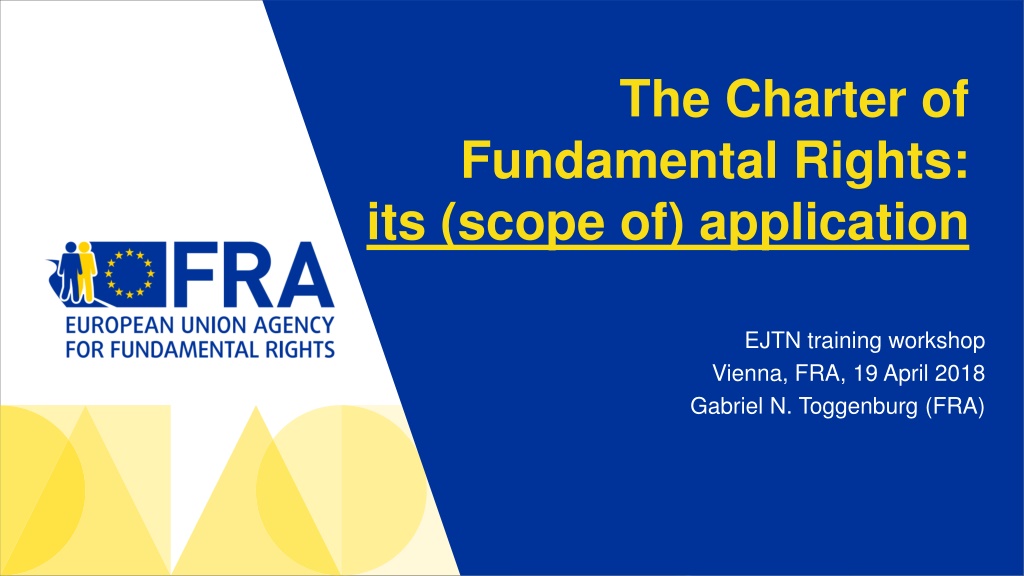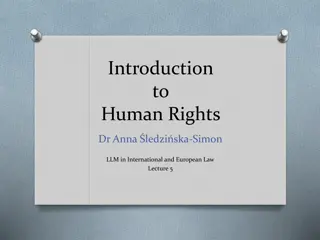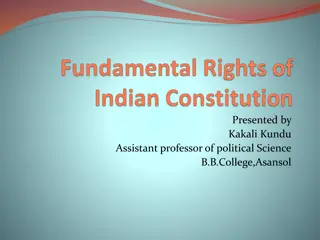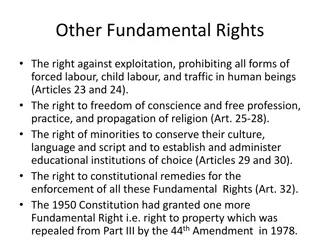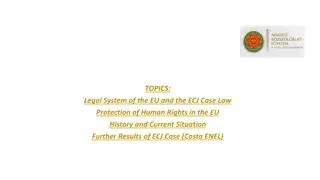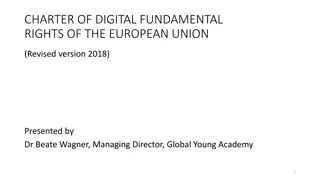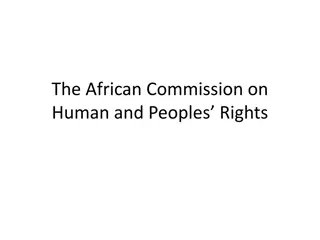Understanding the Scope of the Charter of Fundamental Rights
Delve into the application and implications of the Charter of Fundamental Rights in the context of EU law. Explore its coverage, limitations, relationships with national laws and treaties, and the rights holders and situations it addresses, along with the general rules laid out in Article 52. Gain insights into when national law falls within the scope of EU law and the added value of utilizing the Charter before national courts.
Download Presentation

Please find below an Image/Link to download the presentation.
The content on the website is provided AS IS for your information and personal use only. It may not be sold, licensed, or shared on other websites without obtaining consent from the author. Download presentation by click this link. If you encounter any issues during the download, it is possible that the publisher has removed the file from their server.
E N D
Presentation Transcript
The Charter of Fundamental Rights: its (scope of) application EJTN training workshop Vienna, FRA, 19 April 2018 Gabriel N. Toggenburg (FRA)
What this part covers Section III Section I Section II Section III Digging deeper: When does national law fall within the scope of EU law ? Introduction: What is meant by the scope of the Charter ? The use of the Charter before national courts The Charter s added value 2
Different aspects of the Charters scope Rights covered: very modern, encompassing, innovative Rights holders addressed: individuals and private legal persons (eventually even public entities) Situations covered: limited to those governed by EU law 3
Other aspects: the 7 rules of Article 52 1. General limitations to Charter rights: Article 52 (1) Provided for by law; respect essence; proportional 2. Relationship with Treaties: Article 52 (2) right listed also in the Treaties shall be exercised under the conditions and within the limits defined by those. 3. Relationship with ECHR: Article 52 (3) ECHR as a minimum standard Absolute rights (title I rights plus others) 4
Other aspects: 7 rules of Article 52 4. Relationship with national law: Article 52 (4) Charter as a minimum standard BUT: Case C-399/11 Stefano Melloni (2013) limits space for protection beyond the Charter 5. Limited reach of principles: Article 52 (5) may be implemented by legislative and executive acts . They shall be judicially cognisable only in the interpretation of such acts and in the ruling on their legality 6. national laws and practices: Article 52 (6) Full account shall be taken of those specified in the Charter 5
Other aspects: 7 rules of Article 52 7. Explanations: Article 52 (7) Due regard to be given by the courts of the Union and of the Member States 6
Article 51: The Charters field of application 1. Charter addressed to the Member States only when they are implementing Union law. They shall therefore respect the rights, observe the principles and promote the application thereof in accordance with their respective powers and respecting the limits of the powers of the Union as conferred on it in the Treaties. 2. The Charter does not extend the field of application of Union law beyond the powers of the Union or establish any new power or task for the Union, or modify powers and tasks as defined in the Treaties. 7
Why to oblige MS under the Charter? It is also important to consider the objective of protecting fundamental rights in EU law, which is to ensure that those rights are not infringed in areas of EU activity, whether through action at EU level or through the implementation of EU law by the Member States. CJEU 6 March 2014, Siragusa, Case C-206/13, para. 31. Situations cannot exist which are covered in that way by European Union law without those fundamental rights being applicable. The applicability of European Union law entails applicability of the fundamental rights guaranteed by the Charter. CJEU 26 February 2013, kerberg Fransson, Case C-617/10, para. 21. 8
The mystery of the scope: ECHR vs.CFREU ECHR: All State actions and omissions all State action/omission fully covered EU human rights obligations: coverage by limited to cases where and when the Member State is implementing EU law in the sense of Article 51 of the Charter and the CJEU s case law ( acting within the scope of EU law , in respect of matters covered by EU law etc) 9
Does the Charter add value? In terms of Member State behaviour covered? No In terms of rights covered? Yes In terms of procedural protection offered? Yes 12
Added value: Charter and ECHR In so far as this Charter contains rights which correspond to rights guaranteed by the [ECHR] the meaning and scope of those rights shall be the same as those laid down by the said Convention. This provision shall not prevent Union law providing more extensive protection. (Art. 52 Para 3) 13
The Charters innovative potential 16 14 3 12 NUMBER OF CHARTER ARTICLES 10 4 8 6 12 4 4 2 8 7 2 2 3 3 2 0 I DIGNITY (ARTICLES 1-5) II FREEDOMS (ARTICLES 6-19) III EQUALITY (ARTICLES 20- 26) IV SOLIDARITY (ARTICLES 27- 38) V CITIZEN'S RIGHTS (ARTICLES 39- 46) VI JUSTICE (ARTICLES 47- 50) 14 equivalent protection to ECHR more extensive than ECHR EU context-specific no ECHR equivalent
Equivalent protection to ECHR More extensive than ECHR No ECHR equivalent EU context-specific Peace common values Universa l values Diversity, etc Rights more visible Reaffirms const. and int l rights Rights, duties, responsibilities Rights, freedoms and principles Preamble I Dignity (Articles 1 5) 1 Human dignity 3 Integrity of the person 4 Torture and inhuman degrading treatment or punishment 5 Slavery and forced labour 2 Life II Freedoms (Articles 6 19) 6 Liberty and security 7 Private and family life 9 Marry and found family 10 Thought conscience and religion 8 Personal data 11 Expression and information 12 Assembly and association 13 Arts and sciences 15 Choose occupation and engage in work 14 Education 16 Conduct a business 19 Removal, expulsion or extradition 17 Property 18 Asylum III Equality (Articles 20 26) 20 Equality before the law 21 Non- discrimination 22 Cultural, religious and linguistic diversity 23 Equality: men and women 24 The child 25 Elderly 26 Integration of persons with disabilities IV Solidarity (Articles 27 38) 27 Workers right to information and consultation 29 Access to placement services 30 Unjustified dismissal 31 Fair and just working conditions 28 collective bargaining and action Source of categories: NL HB 32 Prohibition of child labour and protection of young people at work 33 Family and professional life 34 Social security and assistance 36 Access to services of general economic interest 35 Health care 37 Environmental protection 38 Consumer protection V Citizens rights (Articles 39 46) 39 Vote and stand as candidate to EP 40 Vote and stand as candidate at municipal elections 41 Good administration 42 Access to documents 43 European ombudsman 45 Movement and residence 46 Diplomatic and consular protection 44 Petition (EP) VI Justice (Articles 47 50) 47 Effective remedy and fair trial 48 Presumption of innocence and right of defence 49 Legality and proportionality of criminal offences and penalties 50 Ne bis in idem VII General provisions (Articles 51 54) 52 Scope and interpretation 53 Level of protection 54 Prohibition of abuse of rights 15 51 Application
The Charters potential to offer more in terms of substantial rights The Charter also provides rights that are not included in (all) national constitutions as e.g. explicit asylum rights (Articles 18 and 19); rights of the child (Article 24) right to good administration (Article 41) the freedom to conduct a business (Article 16) 16
The Charters potential to offer more in terms of procedural aspects/effects Supremacy and direct effect can play a role when interpreting national law; interpreting EU law; checking national law against the Charter; checking EU legislation against the Charter National courts and authorities are under a duty to apply EU law and set aside conflicting norms of national law (example of Benkharbouche case, 2017) 17
The Charters use at national level Relatively low quantity of references to the Charter before national courts with most references being superficial Low quantity of references to the Charter during the legislative process at national level with most references being superficial Hardly any government policies in place to promote the Charter Scope of the Charter as a stumbling bloc? 18
National courts: the Charters combined use 45 39 40 36 35 31 30 25 Number of references 20 13 15 Number of references to other legal sources alongside the analysed court decisions, by legal source referred analysed for 2017) 10 4 Charter in 3 5 0 ECHR National Constitution CJEU decisions International law Unwritten general principles of EU law ECtHR decisions to (71 decisions (UN Conventions, etc.) 19 legal source referred to
National courts: relevant policy areas Border checks, asylum and immigration 21 Non-discrimination 10 Number of analysed court decisions, by policy area analysed for 2017 Data protection 8 Judicial cooperation in criminal matters 5 Other policy areas 27 0 5 10 15 20 25 30 35 20
National courts: relevant Charter rights Article 47 - Right to an effective remedy and to a fair trial 14 Article 4 - Prohibition of torture 12 Article 7 - Right for private and family life 12 Article 52 - Scope of guaranteed rights 11 Article 8 - Protection of personal data 8 Number of references to respective Charter rights in the 71 decisions analysed for 2017 Art. 21 - Non-discrimination 8 Article 51 - Scope of application 6 Art. 20 - Equality before the law 5 Article 41 - Right to good administration 4 Other articles 36 0 5 10 15 20 25 30 35 40 21
Most relevant Charter rights in RPRs 80 70 60 50 40 30 20 10 0 2013 2014 2015 2016 2017 Article 47 Article 21 Article 4 Article 31 Article 18 Article 41 Other 23
What does implementing EU law mean? the same as acting within the scope of EU law and covers a wide range of situations minimum requirement: there must be some connection with Union law (other than the Charter) this connection is sufficiently concrete if Member States act as agents for the EU or in situations in which they need to rely on some kind of authorization of EU law 24
National acts meant to transpose EU law Covers all kind of legislative or regulatory measures All levels of national measures qualify as implementation Also, national measures using the margin of appreciation granted by EU law (directives) qualify as implementing Union law in the sense of Art. 51: in exercising the discretion granted by the EU legislator, MS have to respect the Charter 25
Pre-existing national legislation Where pre-existing national provisions can ensure that EU law is implemented there is no need for new legislation transposing e.g. an EU directive Such national provisions qualify as implementing Union law Once such norms change form purely internal measures to measures implementing EU law, they have to conform with the Charter 26
Measures not intended to implement EU law Measures that are not designed to implement EU law but fall within the scope of EU law (Case C-555/07, Kuecuedeveci) This is basically about scenarios where a Member States is not properly implementing EU legislation Note: a mere interaction is not sufficient to bring national legislation within the scope of EU law (Case C-206/13, Siragusa or C-198/13 Julian Hernandez) 27
Concepts of national law referred to in EU law National concepts/terms can imply implementation in the sense of Article 51 if used in the context of the EU provisions at issue (see e.g. CJEU, Rodriguez Caballero, Case C-442/00) 28
Concepts of national law referred to in EU law An EU directive relating to the protection of employees in the event of the insolvency states that the directive is without prejudice to national law as regards the definition of the terms such as employee, employer and pay. The directive thus refers to national law; it is for national law to specify these terms and to define them. If these national legal concepts are used in context of that directive, the EU fundamental rights apply, regardless whether it concerns new national legislation specifically made to transpose the directive or whether they are existing national legal concepts (e.g. by virtue of employment law). 29
National law using discretionary powers granted by the EU Qualifies as implementing EU law , regardless of whether it concerns mandatory or optional exercise of discretionary powers (CJEU, Sabou, Case C-276/12 or Milkova, Case C- 406/15) This does not apply if EU law simply recognises existing MS powers to take more favourable provisions (gold plating). Gold plating falls in the scope of EU law if the EU law act makes this explicit: see Art 4(1) AMSD 30
National provision concerning remedies, sanctioning and enforcement If such provisions are used to guarantee the application of EU law they qualify as implementation in the sense of Art. 51 This applies also if EU law does not establish a respective obligation (as in Art 9 Dir 2000/78). See Art. 4 (3) TEU and respective case law Such acts qualify as implementation irrespective of whether they are adopted in order to transpose EU law (e.g. Case C- 218/15, Paoletti; Case C-405/10, Garenfeld) 31
National measures falling under a prohibition and needing EU law authorisation Where Member States risk to discriminate based on nationality, to restrict fundamental freedoms or deprive Union citizens of the genuine enjoyment of their citizens rights they may invoke exceptions: but then they have to respect EU fundamental rights Case C-98/14, Berlington; Case C-368/95, Familiapress; Case C-165//14, Rendon Marin 32
Voluntary references in national law to (concepts of) EU law Per se such references do not bring national law within the scope of EU law (Case C-482/10, Teresa Cicala) However CJEU might have jurisdiction to interpret these terms (and hence the Charter may play a role) if the national law makes them applicable directly and unconditionally in order to ensure that internal situations and situations governed by EU law are treated in same way 33
National measures falls in an area in which the EU has legislative powers Not sufficient to trigger application of Charter Two additional criteria need to be fulfilled: the EU has exercised these powers the national measure falls in the exact scope of application of these legislative measures 34
Criteria to determine field of application 24 requires a certain degree of connection above and beyond the matters covered being closely related or one of those matters having an indirect impact on the other . 25 some of the points to be determined are whether that legislation is intended to implement a provision of EU law; the nature of that legislation and whether it pursues objectives other than those covered by EU law, even if it is capable of indirectly affecting EU law; and also whether there are specific rules of EU law on the matter or capable of affecting it . CJEU, Case C-206/13, Cruciano Siragusa 35
Criteria to determine field of application 26 EU rights could not be applied in relation to national legislation because the provisions of EU law in the subject area concerned did not impose any obligation on Member States with regard to the situation at issue in the main proceedings In particular, the Court has found that fundamental CJEU, Case C-206/13, Cruciano Siragusa 36
Within and beyond the Charters scope EU AUTHORISATION STATE AS EU AGENT SCOPE Charter NOT applicable New legislation formally transposing Exceptions granted by EU primary law Legislation outside the scope of EU law Legislation falling within scope of EU legislation Old legislation substantially transposing National legislation voluntarily using EU law concepts Discretion granted by EU secondary law Goldplating Remedies, sanctions, enforcement National legislation using national legal concepts referred to by EU legislation 37
The END Many thanks for your patience! 38
